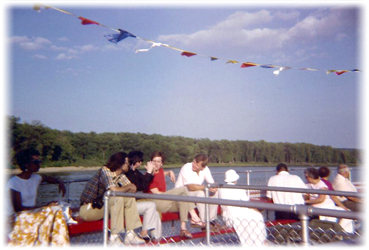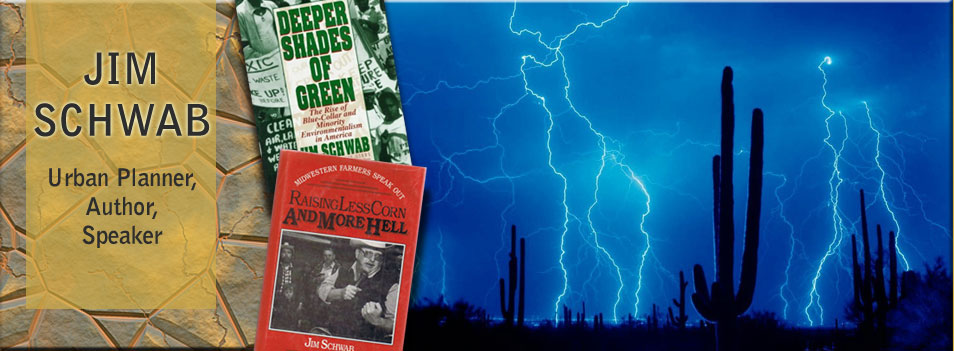Reflections - Community
Our attachments to our communities tend to mutate over the course of a lifetime. Since one in five Americans moves every year, even the communities of which we are a part change. The United States of America has always been a nation with a large population of immigrants, for whom not only community but country has changed, often dramatically. Think of the culture shock, for instance, in moving from Somalia to the U.S. Yet there is a substantial and growing Somali culture in the U.S., one that is finding its own ingenious ways of adapting and assimilating while retaining its own distinct identity, as every other culture has tended to do for centuries.By contrast, my own evolution is modest but nonetheless, for me, significant. I grew up in suburban Cleveland. I now live in the heart of Chicago. In the interim between the two, I lived for several years in Iowa, then married a Nebraskan, settling in Omaha for just a few months before landing a job in Chicago. Because my father grew up in Queens, I was born in New York. If there is consistency, it is that I seem to be moving back and forth along the 41st to 42nd parallel. I am pretty much a life-long Midwesterner.

Cleveland taught me a lot and bred an activist who was transformed into an urban planner, turning commitment to community into a career. The big change came in my college years. Moving from a high-quality suburban high school to a downtown urban university--in 1968, of all years--produced an abrupt awareness of the range of issues facing our urban communities. Cleveland State University, centered at E. 24th and Euclid Avenues, was in the center of a political universe that witnessed civil rights marches, the election of the first black mayor of a major American city (Carl Stokes, 1967-1971), the emergence of an environmental movement for which Cleveland was ground zero in gritty industrial pollution, and a potent anti-war movement that protested the Vietnam conflict in marches that regularly proceeded right past the campus down Euclid Avenue to Public Square. Although I began my academic career as an English major who had founded the Writers Club at Brecksville High School, by my junior year a rapidly growing fascination with the issues of the world lured me to switch majors to political science. Over time, first on campus, and later in the larger community, I became active in a number of organizations.
Eventually, I was offered the position of executive director of the Iowa Public Interest Research Group. I moved to Iowa in January 1979, and social change, in the form of consumer and environmental advocacy, became a full-time job. Iowa PIRG, however, was plagued with more fundraising challenges than I initially realized, and despite some successes, the time came to move on. I applied to graduate school at the University of Iowa, undertaking a double master’s program in Journalism and Urban and Regional Planning. The first let me improve my writing and communication skills, which have always been central to my identity. The second let me acquire vital skills for tackling needed community change on a more professional level. Exactly what I was going to do with those two degrees I had no idea. I simply knew that the combination would let me carve out a unique path ideally suited to my own gifts. I have never looked back on that choice with anything but immense pleasure. I realized I finally understood what I was about and what special talents God had bestowed on me. And I have always felt that talents bestow responsibilities.
It did not take long to find ways to marry those two areas of expertise. I was, like all Journalism M.A. students at Iowa, expected to complete either a Master’s Thesis or Master’s Project. I chose the latter, meaning I needed to complete some journalistic project to complete my program. Either is typically a 40- to 50-page paper or reporting effort on some topic related to journalism or mass
 communication. I chose to undertake a book for publication. The topic: the evolving Midwestern farm crisis of the mid-1980s.
communication. I chose to undertake a book for publication. The topic: the evolving Midwestern farm crisis of the mid-1980s.
My early years in Chicago, following on such close interaction with so many communities across Iowa, induced me to undertake for several years what became a fascinating and fun experiment for dozens of friends. Each summer I organized what we called Iowatrek: a weekend excursion of Chicagoans to small town Iowa, visiting community events and typically staying in bed and breakfasts, each with its own idiosyncratic taste and history. Long-time Iowans will smile with approval upon learning that the Iowatrek caravan—usually a handful of cars with a well-mapped (pre-GPS) itinerary—visited such classic Iowa destinations as Vesterheim and Nordicfest in Decorah, the Bix Beiderbecke Jazz Festival in Davenport, the Mississippi River Museum in Dubuque, and even the tiny Luxemburgish community of St. Donatus, among many others. In the process, thoroughly urban Chicagoans learned a great deal about their neighboring state and learned also that some Iowans were expatriate Windy City residents who had found a new life.
Perhaps the wildest adventure came the year we visited the Villages of Van Buren County, canoeing the Des Moines River from Keosauqua to Bonaparte, then enjoying dinner at Napoleon’s Retreat, with the mayor as our special guest. Along the way, two of five canoes capsized in a river that had been at flood stage three weeks earlier. One of those carried Jean and me. I lost my glasses to a near-sighted catfish in water at least ten feet deep; my treasured Aussie hat, which had provided magnificent shelter from the sun, also floated away or sank. Because I depend on my glasses for adequate vision, and could not replace them quickly, Jean had to drive all the way back to Chicago. She made that task more difficult, after we brought our capsized vessel ashore, by stepping on a wasp.
One must develop a sense of humor to survive in this world. Not that I was laughing at the time. Not right away, at least. But I can now.

After I had developed about 140 pages of material, my adviser basically said enough was enough, you are finished, complete the rest of the book on your own time. The end result, published three years after I completed my degrees, was Raising Less Corn and More Hell, an oral history of the farm credit crisis of the 1980s, published in 1988 by University of Illinois Press. Somehow, in the process, an urban kid from Cleveland who had found his way to Iowa became thoroughly immersed in the ethos and pathos of rural communities in Iowa, Nebraska, Missouri, and Minnesota, among other places, and learned a whole new way of seeing the world and of being accepted in it. I traveled hundreds of farm communities with ease and with a growing understanding of rural society and the challenges of the rural economy and environment. Land use and environment, by the way, had been my area of concentration in studying urban planning at the University of Iowa. In many ways, I was merely applying what I had learned to the Iowa scene that surrounded me.
By the time the book was published, however, I was firmly implanted in the city of Chicago. Now fascinated with book-length journalism, while practicing magazine journalism on a daily basis as the assistant editor of APA’s Planning magazine, and with a growing interest in urban environmental planning, I harked back to my Cleveland roots and found a new book topic: the rapidly growing environmental justice movement. There was plenty of raw material in both Cleveland and Chicago, but I broadened my sights and used networking skills to identify and interview more than 300 people nationwide in places like Louisiana, Southern California, American Indian communities, Appalachia, and the Midwest to stitch together Deeper Shades of Green: The Rise of Blue Collar and Minority Environmentalism in America. The book was in many ways a statement of blue-collar roots and a commitment to justice based on advanced environmental and social awareness that integrated many strands of the complex activist I had become. I began work on the book in 1990; it was published in 1994. Along the way, friends and publishers alike often questioned the viability of the entire topic. Was there such a thing as an African-American, Hispanic, or blue-collar environmental activist? I became acutely aware of the limited frames of vision through which many Americans, most particularly many intellectuals, viewed social movements. Yet today the concept of environmental justice as an analytical framework for social change is widely accepted. It was not just the reality of the community that had to change. The very perception of that reality had to shift as well.
But that was not to be my final personal and professional transformation. Before that book saw the light of day, Bill Klein, the director of research at APA, asked me to take charge of a new project, underwritten by the Federal Emergency Management Agency, to produce a research report on “Planning for Post-Disaster Recovery and Reconstruction.” Because it seemed to have at least a tangential connection with my environmental interests, I agreed. What I did not understand until several years later, after the five-year project was finally over and the report was in print, was how much more than environmental planning is involved in disaster recovery. In fact, the topic covers the entire vast matter of rebuilding entire communities that have been devastated by disaster. It involves environmental restoration, of course, but also community and economic redevelopment, restoration of essential services, rebuilding a sense of community where much community has been lost, and, in the final analysis, as we learned after Hurricane Katrina, rebuilding confidence and creating resiliency that may well have been on the wane for years before disaster finally struck. And that is only the beginning. It is much more complex than even this thumbnail description suggests.
And that is only the beginning. It is much more complex than even this thumbnail description suggests.
Ever since flying to Miami for the annual Florida APA conference in 1992, and joining a tour bus to witness the destruction in south Dade County after Hurricane Andrew, I have increasingly been drawn into a new world of mixed professional disciplines struggling with issues of why disasters seem ever more disastrous, what we can do to mitigate them, and how we can organize our nation, states, and communities, for more effective, resilient, and timely recovery and reconstruction. This commitment has steadily widened my sense of community in the world and the range of options we humans use to confront crisis. It has taken me overseas and across the country, and my photo essays aim to highlight those experiences. To some extent, that worldwide exposure has come at the expense of tighter connections to the community and city immediately surrounding me. I am not as civically involved at the local level as I used to be, although my wife and I retain strong connections to our church congregation, and Jean is only recently retired from teaching in the Chicago Public Schools. She remains involved in public education issues. But there are always limits to how many things one can do well at a given time, and I would rather do well what I am now doing in the planning world than to spread myself too thinly. I have seen a lot and learned a lot. When the day comes, perhaps in retirement, when it is again important to stay closer to home, perhaps it means that I will bring a broader, deeper perspective than ever to whatever I do locally. I think there is a lot to be said for that.
Website Design by Windy Mountain Graphics



